|
|
|
 |
 |
 |
 |
Environmental Change in Post-closure Safety Assessment of Solid Radioactive Waste Repositories
IAEA TECDOC, 2016, 132 p.
This publication describes the work of the Reference Models for Waste Disposal Working Group, one of nine set up as part of programme entitled Environmental Modelling for Radiation Safety (EMRAS II), which concentrated on the improvement of environmental transfer models and the development of reference approaches to estimate the radiological impacts on humans, as well as on flora and fauna, arising from radionuclides in the environment. |
Extraído de: http://pub.iaea.org/books/IAEABooks/11025/Environmental-Change-in-Post-closure-Safety-Assessment-of-Solid-Radioactive-Waste-Repositories
|
 |
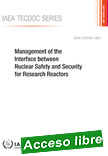 |
Management of the Interface between Nuclear Safety and Security for Research Reactors
IAEA TECDOC, 2016, 53 p.
The objective of this publication is to provide technical guidelines and practical information on managing the interface between safety and security of research reactors. It provides for a better understanding of the elements of that interface, and discuss means to manage it in an integrated manner so as not to compromise safety and security when planning and implementing different programmes and activities. |
Extraído de: http://pub.iaea.org/MTCD/Publications/PDF/TE1801web.pdf
|
 |
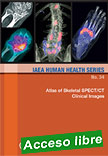 |
Atlas of Skeletal SPECT/CT Clinical Images
IAEA Human Health Series, 2016, 237 p.
The atlas focuses specifically on single photon emission computed tomography/computed tomography (SPECT/CT) in musculoskeletal imaging, and thus illustrates the inherent advantages of the combination of the metabolic and anatomical component in a single procedure. In addition, the atlas provides information on the usefulness of several sets of specific indications. The publication, which serves more as a training tool rather than a textbook, will help to further integrate the SPECT and CT experience in clinical practice by presenting a series of typical cases with many different patterns of SPECT/CT seen in bone scintigraphy.
|
Extraído de: http://pub.iaea.org/books/IAEABooks/10936/Atlas-of-Skeletal-SPECT-CT-Clinical-Images
|
 |
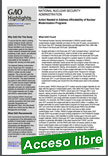 |
To ensure that the nation’s existing nuclear weapons remain safe and reliable, the 2010 Nuclear Posture Review identified a set of long-term modernization goals for the nation’s nuclear weapons stockpile that include sustaining a safe, secure, and effective nuclear arsenal and investing in a modern infrastructure.
|
NNSA, which is responsible for the stockpile, is charged with carrying out these goals. The National Defense Authorization Act for Fiscal Year 2011 includes a provision for GAO to report annually on NNSA’s nuclear security budget materials. This is the sixth year that GAO has undertaken work in response to this provision. This report assesses the extent to which NNSA's fiscal year 2017 nuclear security budget materials (1) differ, if at all, from its budget estimates and plans for modernization activities as presented in its fiscal year 2016 budget materials and (2) align with NNSA’s modernization plans.
GAO analyzed NNSA’s fiscal year 2016 and 2017 nuclear security budget materials associated with those years’ Stockpile Stewardship and Management Plans, and interviewed officials from NNSA and the Office of Management and Budget.
Extraído de: http://www.gao.gov/assets/690/684311.pdf
Highlights: http://www.gao.gov/assets/690/684311.pdf
Report: http://www.gao.gov/products/GAO-17-341
|
 |
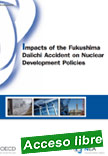 |
Impacts of the Fukushima Daiichi Accident on Nuclear Development Policies
Nuclear Energy Agency (NEA), 06/04/17, 68 p.
Fukushima Daiichi nuclear power plant accident has had an impact on the development of nuclear power around the world. While the accident was followed by thorough technical assessments of the safety of all operating nuclear power plants, and a general increase in safety requirements has been observed worldwide, national policy responses have been more varied. |
These responses have ranged from countries phasing out or accelerating decisions to phase out nuclear energy to countries reducing their reliance on nuclear power or on the contrary continuing to pursue or expand their nuclear power programmes.
This study examines changes to policies, and plans and attempts to distinguish the impact of the Fukushima Daiichi accident from other factors that have affected policymaking in relation to nuclear energy, in particular electricity market economics, financing challenges and competition from other sources (gas, coal and renewables). It also examines changes over time to long-term, quantitative country projections, which reveal interesting trends on the possible role of nuclear energy in future energy systems.
Extraído de: http://www.oecd-nea.org/tools/publication?query=&div=&lang=&period=6m&sort=title&filter=1#p7212
|
 |
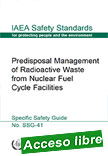
|
Predisposal Management of Radioactive Waste from Nuclear Fuel Cycle Facilities
IAEA Safety Standards Series, 2016, 93 p.
This Safety Guide provides guidance on the predisposal management of all types of radioactive waste (including spent nuclear fuel declared as waste and high level waste) generated at nuclear fuel cycle facilities. These waste management facilities may be located within larger facilities or may be separate, dedicated waste management facilities (including centralized waste management facilities). |
The Safety Guide covers all stages in the lifetime of these facilities, including their siting, design, construction, commissioning, operation, and shutdown and decommissioning. It covers all steps carried out in the management of radioactive waste following its generation up to (but not including) disposal, including its processing (pretreatment, treatment and conditioning). Radioactive waste generated both during normal operation and in accident conditions is considered.
Extraído de: http://pub.iaea.org/books/IAEABooks/10922/Predisposal-Management-of-Radioactive-Waste-from-Nuclear-Fuel-Cycle-Facilities
|
 |
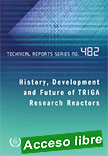 |
History, Development and Future of TRIGA Research Reactors
IAEA Technical Reports Series, 2016, 113 p.
Due to its particular fuel design and resulting enhanced inherent safety features, TRIGA reactors (Training, Research, Isotopes, General Atomics) constitute a ‘class of their own’ among the large variety of research reactors built world-wide. This publication summarizes in a single document the information on the past and present of TRIGA research reactors and presents an outlook in view of potential issues to be solved by TRIGA operating organizations in the near future.
|
It covers the historical development and basic TRIGA characteristics, followed by utilization, fuel conversion and ageing management of TRIGA research reactors. It continues with issues and challenges, introduction to the global TRIGA research reactor network and concludes with future perspectives. The publication is complemented with a CD-ROM to illustrate the historical developments of TRIGA research reactors through individual facility examples and experiences.
Extraído de: http://pub.iaea.org/books/IAEABooks/10943/History-Development-and-Future-of-TRIGA-Research-Reactors
|
 |
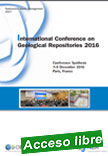 |
International Conference on Geological Repositories - Conference Synthesis
Nuclear Energy Agency (NEA), 04/04/17, 40 p.
Worldwide consensus exists within the international community that geological repositories can provide the necessary long-term safety and security to isolate long-lived radioactive waste from the human environment over long timescales. Such repositories are also feasible to construct using current technologies. |
However, proving the technical merits and safety of repositories, while satisfying societal and political requirements, has been a challenge in many countries.
Building upon the success of previous conferences held in Denver (1999), Stockholm (2003), Berne (2007) and Toronto (2012), the ICGR 2016 brought together high-level decision makers from regulatory and local government bodies, waste management organisations and public stakeholder communities to review current perspectives of geological repository development. This publication provides a synthesis of the 2016 conference on continued engagement and safe implementation of repositories, which was designed to promote information and experience sharing, particularly in the development of polices and regulatory frameworks. Repository safety, and the planning and implementation of repository programmes with societal involvement, as well as ongoing work within different international organisations, were also addressed at the conference.
Extraído de: http://www.oecd-nea.org/tools/publication?query=&div=&lang=&period=6m&sort=title&filter=1#p7345
|
 |
|
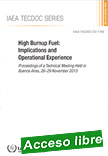
|
High Burnup Fuel: Implications and Operational Experience
IAEA TECDOC (CD-ROM), 2016, 218 p.
A trend towards increasing the discharge burnup of nuclear fuel has been a feature of the operation of virtually all types of nuclear power plants for many years. The increase of the fuel burnup has been implemented in response to the economic challenge to reduce costs associated with nuclear power. Increased dwell allows smaller fuel inventories and fabrication costs on the one hand, and reduced spent fuel volumes to handle and to store or reprocess on the other hand, typically at the expense of higher enrichments.
|
It is also possible to design longer fuel cycles in the reactor, wich can mean higher availability and capacity factor as well as fewer handling operations. However, there are also increased costs associated with high burnup, apart from increased enrichment: large specific decay heats and increased dose rates during transport due larger neutron source intensities in highly burnt fuel have been identified at the back end, as well as new regulatory challenges associated with the precise quantification of safety margins, for example criticality safety, to guarantee high performance during reactor operation and fuel robustness and integrity overall.
It is thus necessary to evaluate safety margins obtained in practice for high burnup fuel from the operational experience in different Member States, to compare these experiences and to assess wheter the expected benefits have been obtained in reality.
The Technical Meeting on High Burnup Fuel Experience, held in Buenos Aires, Argentina, 26-29 November 2013, was a follow uo of two previous meetings, held in Argentina in 1999 and in Bulgaria in 2006, with the purpose to revisit and update the current operational experience and economic conditions associated with high burnup fuel.
Extraído de: http://pub.iaea.org/MTCD/Publications/PDF/TE1798CDweb.pdf
|
 |
 |
NEA Annual Report 2016
Nuclear Energy Agency (NEA), 17/04/17, 70 p.
In many OECD countries, nuclear power is currently under pressure. While only a small minority of countries has decided to phase out nuclear power for political reasons, economic conditions have deteriorated for baseload power plants in recent years, especially in the United States and Europe.
|
This deterioration affects the sustainability of the overall power sector, and the challenge has become particularly difficult for nuclear power plants, which are designed to operate continuously for long periods at essentially full power and to do so for 60 years and longer.
These difficulties concern both the prospects for new nuclear construction as well as the economics of the existing fleet. Without some response to current market conditions, large numbers of nuclear power plants in liberalised markets, in both Europe and the United States, could be shut down in 10 to 20 years either because the owners are reluctant to invest in prolonging plant lifetimes or because normal operations no longer cover variable costs. While the situation is not equally dramatic in all OECD countries, and new plants are being built in France, Finland, Korea, the United Kingdom and the United States, a general slowdown in the construction and planning of new nuclear units can be observed.
(...)
Extraído de: http://www.oecd-nea.org/pub/activities/ar2016/ar2016.pdf
|
 |
 |
Nuclear Security: DOE Could Improve Aspects of Nuclear Security Reporting
Government Accountability Office (GAO - US), April 11, 2017, 40 p.
Department of Energy (DOE) and National Nuclear Security Administration (NNSA) operate sites with facilities holding special nuclear material that can be used to make nuclear weapons. The National Defense Authorization Act of 2014 requires the Secretary of Energy to submit to congressional committees a report detailing the status of security at sites holding key quantities of special nuclear material, along with a certification that the sites meet DOE’s security standards and requirements by December 1 of each year.
|
The law requires DOE’s reports to include a similar report from NNSA. A report accompanying the legislation included
a provision for GAO to evaluate these efforts. This report examines (1) the extent to which these DOE and NNSA reports meet the definition of quality information under federal internal control standards, and (2) any significant physical security challenges at sites that the reports or agency officials identified and the extent to which the agencies have addressed them. GAO reviewed the 2014 and 2015 reports and interviewed agency officials.
Extraído de:http://www.gao.gov/assets/690/684040.pdf
Highlights:http://www.gao.gov/assets/690/684040.pdf
Report:http://www.gao.gov/products/GAO-17-239
|
 |
 |
Development of Radiometric and Allied Analytical Methods and Strategies to Strengthen National Residue Control Programmes for Antibiotic and Anthelmintic Veterinary Drug Residues
IAEA TECDOC, 2016, 254 p.
The information reported in this TECDOC brings together the results of the work completed under the coordinated research project “Development of Radiometric and Allied Analytical Methods and Strategies to Strengthen Residue Control Programs for Antibiotic and Anthelmintic Veterinary Drug Residues” (CRP D52036) with a summary of the key results from the predecessor CRP D32022.
|
The
information is useful for research on, and technology transfer to facilitate, veterinary drug and associated residue testing in food and environmental samples. The TECDOC presents a source of standard operating standards that can be used for step-by-step laboratory procedures.
.
Extraído de: http://pub.iaea.org/MTCD/Publications/PDF/TE1800web.pdf
|
 |
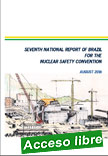 |
Seventh National Report of Brazil for the Nuclear Safety Convention
Comissão Nacional de Energia Nuclear (CNEN), Eletrobras Eletronuclear, Instituto Brasileiro do Meio Ambiente e dos Recursos Naturais Renováveis (IBAMA) e Sistema de Proteção ao Programa Nuclear Brasileiro (SIPRON), August 2016, 214 p.
This Seventh National Report includes relevant information for the period of 2013/2015 and is an update of the Sixth National Report in relation to the Convention on Nuclear Safety articles.
|
Following the recommendations of the Sixth Review Meeting and the Extraordinary Meeting, the information is provided according to the Guidelines Regarding National Reports (INFCIRC/572-Rev5) and the corresponding Summary Reports, which established a different structure for the Report and requested additional information.
The authors decided to prepare the Seventh National Report of Brazil as a selfstanding document, with some repetition of the information provided in the previous National Reports so that the reviewers do not have to consult frequently the previous documents.
The executive summary presents the level of fulfillment of the obligations of the Convention on Nuclear Safety by Brazil. Based in these considerations it can be concluded that Brazil has achieved and has maintained a high level of safety in its nuclear installations. The Brazilian nuclear safety-licensing regime has proved to be effective in implementing and maintaining strong defenses against potential radiological hazard in order to protect individuals, society and the environment of the harmful effects of ionizing radiation, to prevent nuclear accidents with radiological consequences and prompt to act effectively in the case of an emergency. Consequently, Brazil has achieved the objectives of the Convention on Nuclear Safety.
.
Extraído de: http://www.aben.com.br/Arquivos/503/503.pdf
|
 |
 |
Ensuring Robust National Nuclear Safety Systems — Institutional Strength in Depth
IAEA INSAG Series, 2017, 24 p.
Defence in depth has become a fundamental aspect of the analysis of the adequacy of technical systems to assure nuclear power plant safety. It is a comprehensive approach to providing a systematic means to analyse and assure layers of systems to prevent or mitigate accidents.
|
This publication is intended to provide an analogous philosophy to guide the thinking about the institutional structures necessary to assure nuclear safety. It refers to the three important institutional subsystems – the industry, regulator and stakeholders – and describes the interfaces that should be nurtured among these as well as within each subsystem. The publication is intended to serve as a fundamental tool in the continuing efforts to strengthen nuclear safety.
.
Extraído de: http://pub.iaea.org/books/IAEABooks/11148/Ensuring-Robust-National-Nuclear-Safety-Systems-Institutional-Strength-in-Depth |
 |
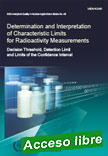 |
Determination and Interpretation of Characteristic Limits for Radioactivity Measurements - Decision Threshhold, Detection Limit and Limits of the Confidence Interval
IAEA Analytical Quality in Nuclear Applications Series, 2017, 149 p.
Since 2004, the environment programme of the IAEA has included activities aimed at developing a set of procedures for analytical measurements of radionuclides in food and the environment. Reliable, comparable and fit for purpose results are essential for any analytical measurement.
|
Guidelines and national and international standards for laboratory practices to fulfil quality assurance requirements are extremely important when performing such measurements. The guidelines and standards should be comprehensive, clearly formulated and readily available to both the analyst and the customer.
ISO 11929:2010 is the international standard on the determination of the characteristic limits (decision threshold, detection limit and limits of the confidence interval) for measuring ionizing radiation. For nuclear analytical laboratories involved in the measurement of radioactivity in food and the environment, robust determination of the characteristic limits of radioanalytical techniques is essential with regard to national and international regulations on permitted levels of radioactivity. However, characteristic limits defined in ISO 11929:2010 are complex, and the correct application of the standard in laboratories requires a full
understanding of various concepts.
This publication provides additional information to Member States in the understanding of the terminology, definitions and concepts in ISO 11929:2010, thus facilitating its implementation in Member State laboratories.
Extraído de: http://pub.iaea.org/MTCD/Publications/PDF/AQ-48_web.pdf |
| |
| |
|
|
| |
| |
|
|
| |
| |
|
|
| |
| |
|
|
|
|
|
|
|
